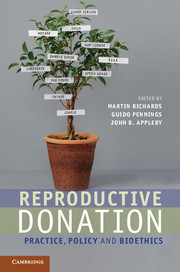Book contents
- Frontmatter
- Contents
- Contributors
- Acknowledgements
- 1 Introduction
- 2 The biology of donation
- 3 Ethics for reproductive donation
- 4 Parenthood – whose right is it anyway?
- 5 Reproductive donation
- 6 UK and US perspectives on the regulation of gamete donation
- 7 Gamete and embryo donation
- 8 The legal and ethical regulation of transnational donation
- 9 Balancing ethical criteria for the recruitment of gamete donors
- 10 Challenges in intra-family donation
- 11 ARTs and the single parent
- 12 Reproductive donation and justice for gay and lesbian couples
- 13 Is disclosure in the best interests of children conceived by donation?
- 14 Identifiable donors and siblings
- 15 Ethical issues in embryo donation
- 16 Reproduction through surrogacy
- 17 Some conclusions regarding the interaction of normative and descriptive elements in reproductive donation
- Index
- References
5 - Reproductive donation
Global perspectives and cultural diversity
Published online by Cambridge University Press: 05 August 2012
- Frontmatter
- Contents
- Contributors
- Acknowledgements
- 1 Introduction
- 2 The biology of donation
- 3 Ethics for reproductive donation
- 4 Parenthood – whose right is it anyway?
- 5 Reproductive donation
- 6 UK and US perspectives on the regulation of gamete donation
- 7 Gamete and embryo donation
- 8 The legal and ethical regulation of transnational donation
- 9 Balancing ethical criteria for the recruitment of gamete donors
- 10 Challenges in intra-family donation
- 11 ARTs and the single parent
- 12 Reproductive donation and justice for gay and lesbian couples
- 13 Is disclosure in the best interests of children conceived by donation?
- 14 Identifiable donors and siblings
- 15 Ethical issues in embryo donation
- 16 Reproduction through surrogacy
- 17 Some conclusions regarding the interaction of normative and descriptive elements in reproductive donation
- Index
- References
Summary
One of the most striking aspects of assisted reproductive technologies (ARTs) has been their rapid globalization. Although ARTs may pose a range of (financial, practical, emotional, psychological, as well as moral) challenges for both providers and users, they have ultimately been embraced by many diverse cultures. ARTs speak to the fundamental desire to become a parent, albeit in a very particular way, and as such enjoy a wide global appeal that transcends many cultural divergences. However, although ARTs may have become ‘global’, their practice in different parts of the world has been subject to a range of limitations, modifications and prohibitions. These context-specific ‘arenas of constraint’ have mediated and defined the ways in which ARTs are offered to and received by local men and women, and have set up specific relationships between technology and culture (Inhorn, 2002). Particularly during the last two decades, a wealth of research has been dedicated to documenting the processes of ‘localization’ by which ARTs have been reconfigured in different global contexts, including debates regarding the morality and acceptability of certain technologies, the impact of socio-economic circumstances, and the experiences of men and women undergoing infertility treatment (for a review of this literature, see Inhorn and Birenbaum-Carmeli, 2008). While this scholarship does not (yet) provide us with a comprehensive survey of practices and attitudes regarding assisted reproduction in all global locations, it nevertheless highlights great cultural diversity through the exploration of a range of similarities and differences, patterns and outliers. Within this broad picture of cultural diversity in ARTs, the heterogeneity regarding reproductive donation – in other words the use of donor sperm, donor eggs and surrogates – is arguably the most varied, interesting and controversial.
- Type
- Chapter
- Information
- Reproductive DonationPractice, Policy and Bioethics, pp. 70 - 89Publisher: Cambridge University PressPrint publication year: 2012
References
- 1
- Cited by



